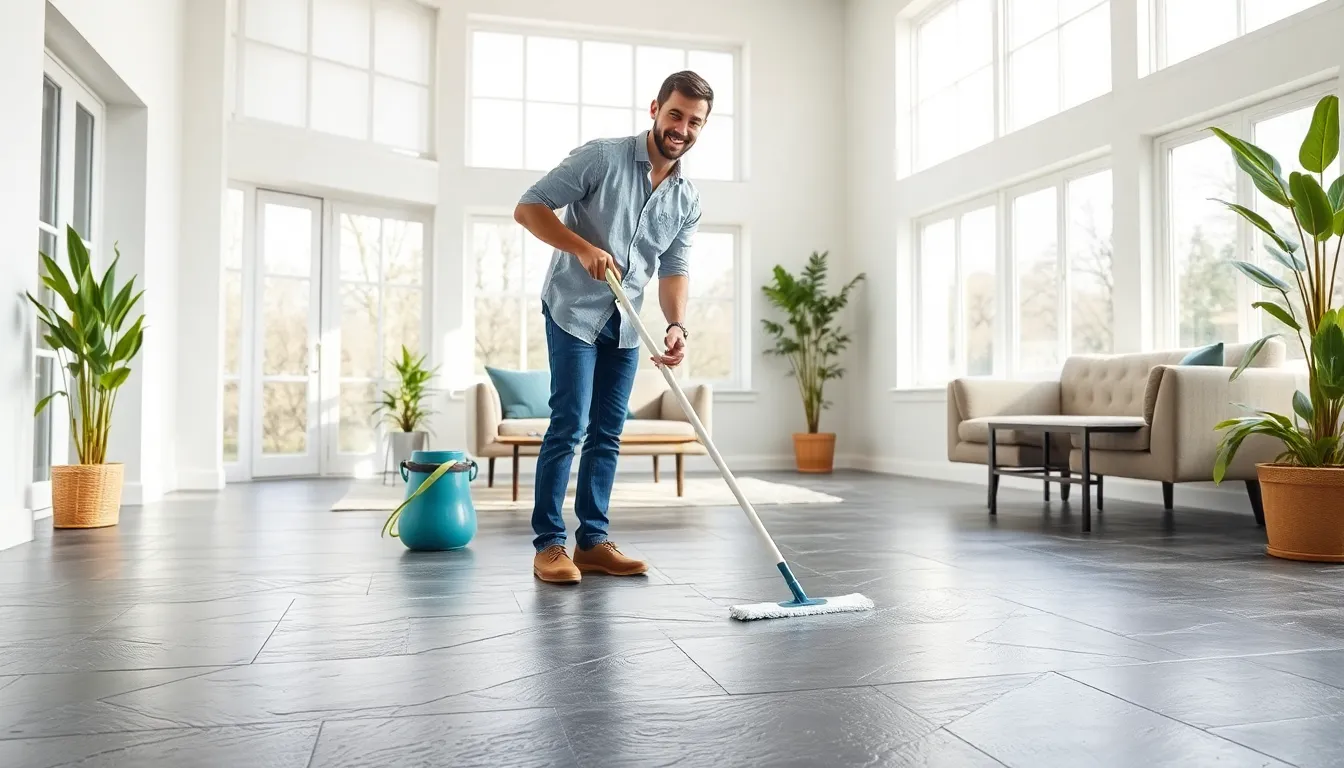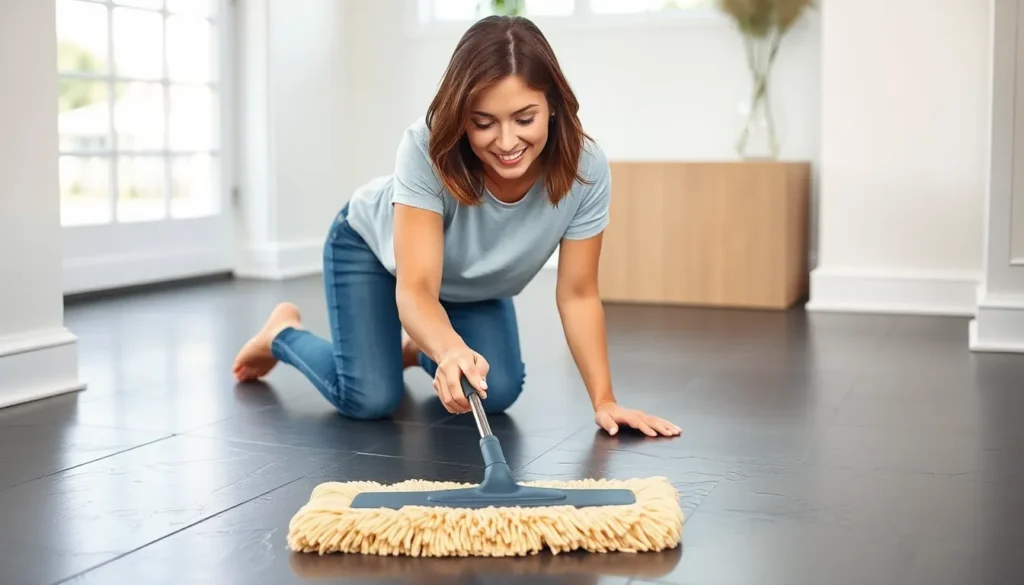Table of Contents
ToggleCleaning slate floors can feel like a daunting task, but it doesn’t have to be a battle of wills between you and those stubborn stains. With the right approach, you can transform your slate from drab to fab in no time. Imagine your floors sparkling like they just stepped off the showroom floor, ready to impress every guest who walks through your door.
Essential Tools For Cleaning Slate Floors
Cleaning slate floors requires specific tools and solutions to achieve optimal results. Proper equipment not only simplifies the process but also protects the natural beauty of the slate.
Cleaning Solutions
Use pH-neutral cleaners specifically designed for stone surfaces. These cleaners effectively remove dirt without causing damage. For tougher stains, a mixture of warm water and mild dish soap can prove effective. Avoid acidic or abrasive products as they can etch the slate surface. Some homeowners opt for natural vinegar or baking soda solutions, but caution is essential to prevent surface deterioration. Regular application of a suitable cleaning solution keeps the slate looking its best.
Cleaning Equipment
Employ a soft-bristle broom or dust mop for routine sweeping. This type of equipment removes dust and debris without scratching the surface. Microfiber mops provide excellent results for damp cleaning; they trap dirt without leaving streaks. When it comes to scrubbing, a soft sponge or cloth works wonders for spot cleaning stains. Avoid using steel wool or harsh scrubbers that can damage the slate. The right equipment makes a significant difference in maintaining the slate’s appearance and longevity.
Step-by-Step Guide On How To Clean Slate Floors

Cleaning slate floors involves a few simple yet effective steps that ensure stunning results. Proper preparation, cleaning techniques, and finishing touches contribute to maintaining the slate’s appearance.
Preparing The Area
Start by removing furniture and rugs from the floor. Clear all items to create space for cleaning. Next, sweep the slate surface with a soft-bristle broom to eliminate dirt and dust. Use a vacuum cleaner with a soft brush attachment to pick up finer particles. Inspect the slate for stubborn stains or spills. Address any spots that require special attention before moving on.
Cleaning The Slate Floors
Mix a pH-neutral cleaner with warm water in a bucket according to the manufacturer’s instructions. Dip a microfiber mop into the solution and wring it out to avoid excess moisture. Mop the slate floors, starting from one corner and working toward the exit to prevent stepping on wet areas. For tougher stains, apply a mixture of mild dish soap and warm water directly to the affected spots. Allow it to sit for a few minutes to break down the stain before wiping it with a soft cloth or sponge.
Drying And Finishing Touches
Allow the slate floors to air-dry completely after mopping. Ensure proper ventilation by opening windows or using fans. After drying, check for any remaining grime or streaks. Buff the surface gently using a dry microfiber cloth for added shine. Lastly, consider applying a stone sealer if recommended, which can enhance the slate’s durability and resistance to stains.
Maintaining Slate Floors
Maintaining slate floors requires consistent care to keep them looking their best. Regular attention prevents dirt buildup and prolongs the life of the surface.
Regular Cleaning Schedule
Establish a consistent cleaning routine for maintaining the beauty of slate floors. Weekly sweeping or dust mopping removes loose debris and prevents scratches. Monthly damp mopping with a pH-neutral cleaner enhances shine and cleanliness. For high-traffic areas, consider cleaning twice a week for optimal upkeep. Spot clean as needed to address specific stains promptly. By sticking to a regular schedule, the slate retains its appeal over time.
Preventative Measures
Implementing preventative measures safeguards slate floors from damage and staining. Place mats at entry points to trap dirt and moisture before it hits the floor. Use protective pads under furniture to prevent scratches from movement. Regularly check for cracks or chips and address them immediately to avoid further deterioration. Applying a stone sealer every 6 to 12 months enhances resistance to stains and spills. These measures collectively preserve the slate’s integrity, ensuring lasting beauty.
Common Mistakes To Avoid
Avoiding common mistakes ensures better care for slate floors. Incorrect cleaning methods lead to damage or ineffective results.
Using Harsh Chemicals
Using harsh chemicals can seriously harm slate surfaces. Acidic cleaners or abrasive scrubbing pads cause scratching and discoloration over time. Opting for pH-neutral cleaners specifically designed for stone surfaces preserves the slate’s integrity. Always prioritize gentle cleaning solutions to remove grime without damaging the finish. When in doubt, test any cleaner in an inconspicuous area before wider application.
Skipping Routine Maintenance
Skipping routine maintenance invites dirt buildup and stains. Regular cleaning with a soft-bristle broom or dust mop prevents grit from scratching the surface. Establishing a consistent cleaning routine keeps slate floors looking their best. Failing to mop with a pH-neutral solution can lead to dullness and a worn appearance. Set aside time for monthly damp mopping, especially in high-traffic areas, to maintain the slate’s shine and longevity.
Cleaning slate floors doesn’t have to be daunting. With the right tools and techniques, anyone can maintain the beauty and durability of their slate surfaces. Regular upkeep is essential to prevent dirt buildup and prolong the life of the flooring. By following a consistent cleaning schedule and using appropriate products, slate floors can remain inviting and impressive for years to come.
Implementing preventative measures and avoiding common mistakes ensures that the slate retains its shine and resists stains. With a little care and attention, slate floors can continue to enhance any space, providing both functionality and aesthetic appeal.




